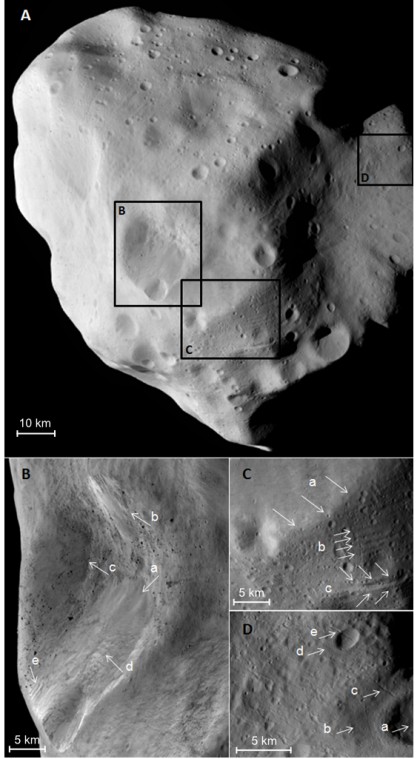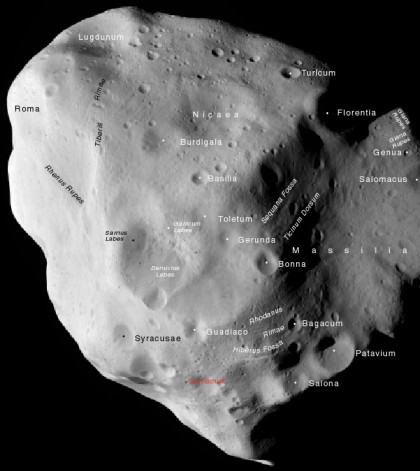Press Release 23/2011 - October 28, 2011
Primal rock in space
The Lutetia asteroid could be a remnant from the early phase of the solar system.
Lutetia is a real fossil: several areas of the asteroid's surface are around 3.6 billion years old and thus some of the oldest in the planetary system. Its high density means Lutetia is also a planetesimal, the first stage of development on the way to becoming a planet. These findings have been obtained by scientists headed by the Max Planck Institute for Solar System Research. The team has evaluated images which the Rosetta space probe recorded during its fly-by of Lutetia in July 2010.
Some 4.5 billion years ago the solar system looked totally different to what it does today: instead of the eight large planets there was first a cloud, then later a disk of gas and dust orbiting the newly formed Sun. This matter gradually amalgamated to form irregular shaped lumps, so-called planetesimals. Some of them fused to even larger rocks, the proto-planets - although they were still smaller than today's planets they were already spherical and had an inner layered structure. Space is a dynamic place, however: most planetesimals and proto-planets which did not develop further into real planets fragmented again as the consequence of massive collisions.

|
Figure 1: The Lutetia asteroid in Photo A, which Rosetta obtained during the fly-by in July 2010, resembles an overgrown potato. Photo B shows a crater with a diameter of 21 kilometres in the Baetica region; the arrows a, b and c indicate landslides. In Photo C the three arrows illustrate the clearly visible border between the Baetica and Noricum regions, the arrows b and c point to furrowed structures. In the partial Photo D the arrows point to further furrows.
|
(Credits 1: ESA 2010 MPS for OSIRIS Team MPS/UPD/LAM/IAA/RSSD/INTA/UPM/DASP/IDA)
|
"Lutetia is a bit of luck for us", says Holger Sierks, scientist at the Max Planck Institute for Solar System Research, head of the OSIRIS camera team and lead author of the study now published in Science. "Only a very small number of celestial bodies have remained from such an early phase of development. They enable us to cast a look back into the past".
further example is the asteroid Vesta, which NASA's Dawn space probe has been orbiting since July of this year. Researchers assume that Vesta is also one of the few remaining proto-planets. Lutetia could now enable researchers to look even further back - to the very origins of the solar system. Its small size, irregular shape and, above all, its high density point to the fact that it is a planetesimal. "From the images we have now been able to determine the volume of Lutetia very accurately and then in a second step its density", explains Sierks. At 3.4 grams per cubic centimetre it is considerably higher than that of granite.
"Most of the other planetoids which we know in more detail have a much lower density", says Sierks. "We think these asteroids are a kind of cosmic fragment - i.e. relatively loose, porous conglomerations of bodies from previous collisions. Lutetia, in contrast, appears to be significantly more compact - and thus older.

|
Figure 2: The Lutetia asteroid is a small world of its own - with craters, deep furrows and mountain chains. The researchers were able to identify seven regions, whose morphological characteristics differentiate them from each other.
|
(Credits: ESA 2010 MPS for OSIRIS Team MPS/UPD/LAM/IAA/RSSD/INTA/UPM/DASP/IDA)
|
The distribution of the craters on Lutetia's surface, which were formed by later impacts, also indicates a compact structure. This is because, compared to other asteroids, Lutetia has an astonishingly low number of smaller craters with a diameter of less than ten kilometres in particular. The situation resembles the experiment with a steel ball which is thrown with great force either onto concrete or into a sand pit. Since the loose sand can absorb a large portion of the impact energy, only a small hollow is formed in the sand. The same shot produces a large indentation in the significantly more compact concrete, however.
The very high total number of craters also told the scientists that parts of the surface of the asteroid are up to 3.6 billion years old, because the longer a surface is exposed to the continuous cosmic bombardment, the more craters it will have. "Whether Lutetia also has the beginnings of an inner layered structure cannot be said with any certainty at this point in time", explains Holger Sierks. There are a number of indications, but only further investigations of the data obtained can bring certainty here.
"Lutetia has taken us completely by surprise", admits the Max Planck researcher. "Instead of a uniform, comparatively inconspicuous asteroid we have found a small world of its own - with a complex geography". The scientists not only discovered huge craters with diameters of more than 55 kilometres on the images, but also indications of landslides, deep furrows and mountain chains. Overall, the experts were able to identify seven regions, whose morphological characteristics mean there are significant differences between them.
The Rosetta space probe flew past Lutetia in July 2010 on its way to the comet Churyumov-Gerasimenko. The planetoid orbits the Sun in the so-called asteroid belt between the orbits of Mars and Jupiter. Rosetta was launched into space in 2004 and should reach its target in 2014. The OSIRIS onboard camera system was developed and built under the direction of the Max Planck Institute for Solar System Research in collaboration with a team made up of members from six European countries. It comprises a wide-angle and a telephoto camera. OSIRIS is operated by researchers at the Max Planck Institute.
Original Publicatioon
H. Sierks et al.:
Images of Asteroid 21 Lutetia: A Remnant Planetesimal from the Early Solar System
Science, October 28, 2011
Additional Information
 Dawn-Website at MPS
Dawn-Website at MPS
Contact
Dr. Birgit Krummheuer
Press and Public Relations
Max Planck Institute for Solar System Research
Max-Planck-Straße 2
37191 Katlenburg-Lindau
Tel.: 05556 979 462
Fax: 05556 979 240
Mobil: 0173 3958625
Email: krummheuer mps.mpg.de
mps.mpg.de
Dr. Holger Sierks
Max Planck Institute for Solar System Research
Max-Planck-Straße 2
37191 Katlenburg-Lindau
Tel: 05556 979 242
Email: sierks mps.mpg.de
mps.mpg.de
